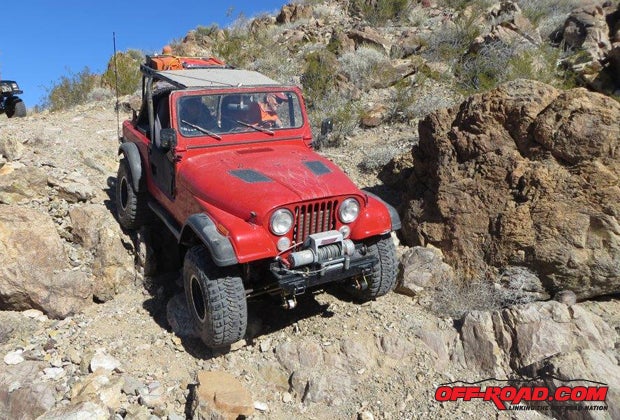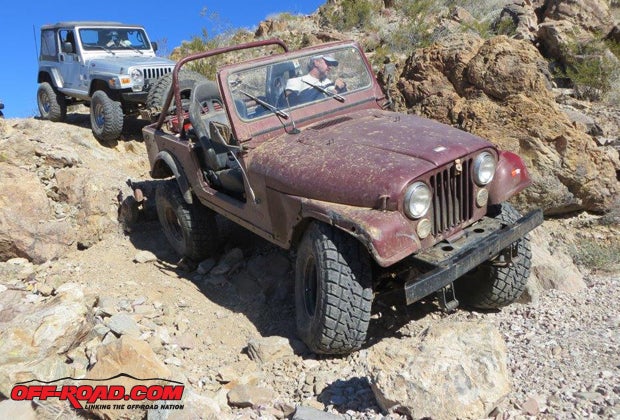
In your Jeep Creep questions, please list your first and last names, your hometown, and your state/province/country, so that we can publish that information here. If you don’t provide this information, we may not be able to publish your question and answer. Don’t forget to be as complete as possible with the description of your Jeep and its problems, too. Send your Jeep questions to editor@off-road.com, Attn: Jeep Creep.
Previous Jeep Creep Columns
January 2013
No Jeep recalls from NHTSA this month.
Low-Powered YJ
I can’t figure it out. Off-road or in stop-and-go traffic, my ‘93 YJ with the 4.0L six-cylinder and three-speed automatic seems to have enough power for its tires and gears (32-inch tires and 3.07:1) and engine seems to rev up normally. However, on long drives it has trouble maintaining freeway speeds. Even if I down-shift to second, the RPM won’t go above 2,400. It doesn’t heat up (although adding a winch to the front bumper caused the temperature to go up to about 200 degrees from its normal 180) and oil pressure remains the same. The Jeep’s engine just won’t go any higher.
Jim Roberts
Costa Mesa, CA
Jim, I think you’re suffering from too much back pressure. It’s kind of like sticking a potato in the tailpipe. It doesn’t allow the engine to breathe. An internal-combustion engine is basically an air pump—the more air you can pump, the faster it can run. If an air filter or fuel pump is restricted, the engine can’t operate fully because it’s not getting enough input air and/or fuel. If the muffler or catalytic converter is partially blocked, it won’t allow the engine to operate at its most efficient. If the muffler, catalytic converter, or tailpipe (remember the potato) is fully blocked, the engine won’t run at all. I once had a catalytic converter that was almost completely blocked by a bad load of fuel. Once it killed the engine, I was forced to park it for an hour or so, drive it for about 15 minutes, and wait another hour or so. I was finally able to limp into a dealership and have the catalytic converter replaced. You can check for excessive back pressure in two ways: Either remove the muffler and/or catalytic converter and drive the Jeep to ascertain if it’s performing up to its potential, or check it with a back pressure gauge. I would bet that driving the Jeep around without a muffler or catalytic converter is illegal in California so I’d chose the second choice. You can pick up a back pressure gauge from Harbor Freight for a fairly reasonable price and follow its instructions on its use. Start with the muffler and move “upstream” to the catalytic converter if the muffler is okay and check the back pressure in front of the catalytic converter. If either is partially plugged, you’ll have to replace the bad part. However, remember if the converter is bad, the muffler may also be bad; you’ll want to double check it after making sure the catalytic converter is operating properly.
Won’t Run
I changed the transmission on my 1996 Jeep Grand Cherokee and now it will not run. It starts and stops, starts and stops. Can anybody out there tell me what I did wrong?
Ray
Brooklyn, New York
Ray, check the security system first then the crankshaft sensor. You may need to read the codes to help with the fix. If it’s a crankshaft sensor problem, the engine computer has nothing to read after you release the key from the start position. You may need a quality shop to trace down the problem.
Master ‘Kee Question
I’m wondering that when building your XJ, did you use any wheel spacers for those rims? If so, what kind and how many inches did you go with?
Andrew Erwin
Clinton, South Carolina
As a matter of fact, Andrew, we didn’t use any spacers. They weren’t necessary with the wheel offset. And I don’t believe we’ll have any turning issues either.
Flickering Headlights
I have had this problem for at least a year and cannot find any help or answers. We just returned from a month-long trip in our ’02 Jeep Wrangler long wheelbase and it did it on the whole trip. The problem is the lights flicker. They flickered on the whole trip until we came home but now all is fine.
Woody Hoff
Las Cruces, NM
Auto electrical systems have become more complex over the years, but the basic principles remain the same. As you know, the alternator powers the vehicle while recharging the battery at the same time; however, a problem has surfaced with some systems. It is the tendency to “strobe,” causing the lights to flicker. Diagnosing the problem could take the backyard mechanic a few minutes, but fixing it could take up to an hour.
1. Check the alternator with a voltmeter. The most common reason for flickering lights is a worn-out alternator, as one of the rotating plates that generate electricity wears out. So as the unit hits the “dead spot,” the power wanes, causing the lights to flicker. The voltage should be over 13, ideally over 14 volts. Automotive parts shops will likely have a machine to test the alternator for free. Replace the alternator if it fails to produce more than 13 volts, or if it tests bad. Most alternators since the 1970s have internal voltage regulators, but for external models this unit is mounted close to the alternator and can cause part failure.
2. Check for loose or disconnected ground cables. Some on-board engine computer systems are sensitive to loose connections, affecting the ignition system as well. A ground strap or cable is on the engine and sometimes on the transmission. Many electrical items on the Jeep, including the ignition system, will depend greatly on these ground connections. Wobbling bolts or intermittent connections can cause the lights to flicker. Tighten these grounds, as well as the primary battery ground wire.
3. Check for loose or disconnected ignition wires. On Jeeps, there is one wire for each spark plug. When they come loose, up to 70,000 volts of electricity can ground out every time the wire is fired by the distributor. This can cause severe light flickering and may damage sensitive electronics.
4. Check the battery’s acid level, and test separately for charge capacity. A battery losing its ability to charge correctly may cause a weak flicker in the lighting system. On some models, a separate positive lead wire goes into a junction box nearby. This box can corrode, as it is often underneath the battery where acid collects. Once corroded, the junction box does not allow for full current transfer, and when the Jeep is in motion it may wobble or bump.
Is Recall Free?
Did Chrysler agree to replace TIPM modules and pay the cost in Australia? The recall listing you published is a little confusing.
Amelia Neale
You’re asking about a recall, which is listed for information purposes for Jeep owners only. If you’re confused or want more information on the recall notice in regards to your Jeep, call the 800 number listed in the notice. If you’re in Australia, ask your phone service provider for information on calling an 800 number in the U.S. Here’s the recall notice again: 13V-282: Chrysler is recalling certain model year 2011-2012 Jeep Liberty vehicles manufactured June 17, 2011, through August 15, 2012. Electrical over-stress of a resistor in the occupant restraint control module may lead to the non-deployment of the active head restraints during a rear impact collision. In the event of a crash necessitating the deployment of the active head restraints, their non-deployment could increase the risk of injury. Chrysler will notify owners, and dealers will flash the Totally Integrated Power Module (TIPM) or replace the occupant restraint control module, as needed, free of charge. The recall is expected to begin in August 2013. Owners may contact Chrysler at (800) 247-9753.

400 V8 or 350 V8?
I’m thinking about putting a Chevy 400 in my CJ7. I haven’t really heard about anyone doing this, and I’m wondering if it would be easier just to put the 350 in it?
Henry Artemis
Henry, I had a Chevy small-block 400 cid V8 in my ’82 CJ7 for several years. It worked really well for a while, but after a time it began to overheat while on the freeway. In a few months it also began to overheat on surface streets, and then off-road as well. Since a 400 is a small block, it is bored out to the maximum for the small-block design. This creates problems with the water jackets, and once it’s a worn engine with some miles on it, overheating becomes a common and increasing factor. Stick with the 350—as I eventually did—and you’ll be really happy with the results. (Check last month’s Jeep Creep for more information on building an awesome CJ7.)
Roaring Grand
I have an ‘04 Grand Cherokee with a 4-inch Rough Country lift and 265-75-16 tires. When I lock it in four-wheel drive it makes a roaring noise. It has the part-time four-wheel-drive system. I have been told it needs a slip yoke eliminator kit to help with the angle of the shaft. It also has spacers on the transfer case cross member to drop it down 1 inch so what would I need to do to eliminate the noise?
Jeff Whalen
Check to see if your front driveshaft is rubbing on the skid plate, or if the front driveshaft’s angle is too steep also. While installing the lift kit, did you completely remove or separate either one of the driveshafts? When a driveshaft is separated, it may be re-assembled with an incorrect “clocking.” In other words, the U-joints are not aligned properly, so make sure this has not happened. If all else fails, you may need to install a slip-yoke eliminator.
Wandering Seven
I have a 1983 CJ7 that I built. I have 40-inch Mickey Thompson tires on it and one-ton Chevy axles, but I have no steering stabilizer setup on it. The Jeep wanders back and forth a lot when on the road. Will a stabilizer system help take care of the problem?
Chris Gotta
With 40-inch tires I’d suggest a double steering stabilizer rather than a single unit; also torque down all the nuts and bolts on the springs and on the steering components. With that much weight—tires and wheels—on the front axle, every component has to be exactly right for it to operate properly.
As usual, each month, I’m shouting out a huge THANK YOU to Paul Schupp at Rock Lizard 4x4 in Kingman, Arizona, for his invaluable assistance in answering many of the Jeep Creep questions.
Send your Jeep questions to editor@off-road.com, Attn: Jeep Creep.
Previous Jeep Creep Columns
January 2013


 Your Privacy Choices
Your Privacy Choices